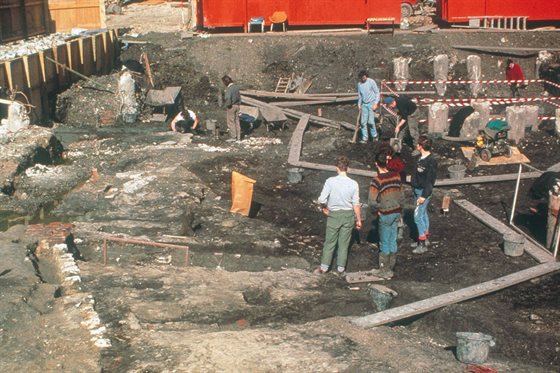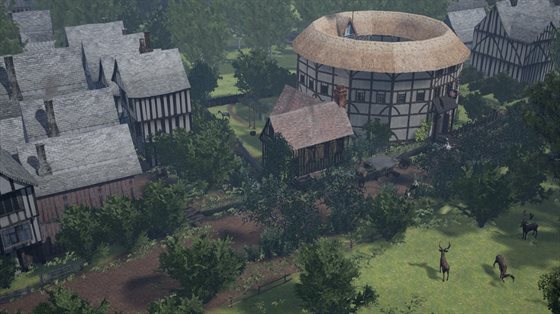WATCH: Immersive video allows you to experience life for Elizabethan theatregoers
A playhouse from the days of Shakespeare has been brought back to virtual life to shed new light on a key period in English theatre history.
The Rose Playhouse in London was opened in 1587 and within five years was remodelled to add a roof over the stage to allow for ever more elaborate ‘special effects’. Productions included Marlowe’s Doctor Faustus, Kyd’s Spanish Tragedy and Shakespeare’s Henry VI part I.
Now visitors and viewers can experience what it could have been like for Elizabethan theatregoers and learn more about life inside the playhouse thanks to a new 3D computer model of the Rose set in its environment of 16th century Bankside, created by former De Montfort University Leicester (DMU) lecturer Roger Clegg.
A flythrough video of the model has been created and is being seen by visitors to the exhibition at the site of the playhouse remains in Southwark, London.
Demolished in 1606, the Rose Playhouse was brought back into the public eye in 1989, when an archaeological excavation was carried out in Southwark and a huge campaign swung into action to preserve the site, supported by actors such as Dame Judi Dench, Sir Patrick Stewart, Sir Ian McKellen and Sir Laurence Olivier.
Dr Clegg, who documents the research in a new, open-access digital book Reconstructing the Rose was supported in the work by a grant from DMU and worked with experts from MOLA (Museum of London Archaeology) who excavated the playhouse foundations in 1989.
MOLA archaeologist Julian Bowsher, who directed the excavation and has written widely about the Rose and London’s other Tudor playhouses, said:“It is a pleasure to see the results of MOLA’s excavations, and insights from the extensive research we have carried out in the thirty years since, re-examined and interpreted in an exciting new way.
 Copyright: MOLA
Copyright: MOLA
"The 3D reconstruction of the Rose is a major development and is a significant contribution to understandings of ‘playhouse design’.”
Each chapter of the new book shares how evidence from the archaeological dig, historical documents and the texts of plays that were staged at the Rose helped shape the details of the model, from the stage trap door known to be in use in the playhouse post-1591 to the office that may have belonged to entrepreneur and owner of the Rose, Philip Henslowe.
“Several visualisations of Henslowe’s playhouse have been produced in an attempt to understand what the Rose may have been like”, explains Dr Clegg, “but this model uniquely makes available the evidence that has informed its design. The project makes transparent for the viewer which aspects of the model are based in fact and which in conjecture, and discusses alternative possibilities where evidence is open to interpretation.
"Created for the Rose Theatre Trust, it is hoped the work provides greater insight into the relationship between the excavated remains and the now sadly absent playhouse superstructure.”

Dr Clegg’s connection to the Rose playhouse dates from 2014, when he attended a talk on plans to re-excavate the playhouse remains and to display them in a new purpose-built exhibition and performance venue.
He saw an opportunity to use virtual reality (VR) to communicate to visitors how the Rose playhouse once looked and what it would have been like to visit and watch a play.
Harvey Sheldon, Chair of the Rose Theatre Trust who contributed the foreword to the book, writes, ”Visitors to the Rose are interested in learning about how the now missing superstructure of the building may once have been like, and what details can be established about the architecture as well as the decorative schemes that might have adorned the playhouse’s interior.
"For these reasons the Trust was delighted when Roger Clegg approached us with a view to creating a ‘fly–through’ of a computer model enabling our site visitors to experience a re-creation of the Rose as a standing building. Whether as an immersive experience or viewed as a video, the model will enable visitors to enter the Rose and examine how it might have appeared to playgoers.”
Dr Clegg, who was a senior drama lecturer at DMU until moving to Australia, worked with Game Art student Chris Stone to create an initial prototype of the model.
The computer modelling was then taken up by former DMU lecturer Dr Eric Tatham (Mixed Reality Ltd.) and DMU’s Professor of Shakespeare Studies, Gabriel Egan brought in to advise. Professor Egan's own work on Shakespearean London Theatres, including the Rose, can be seen here. The voice over for the video was postgraduate drama student Chris Howitt.
The open-access book, which incorporates video fly–throughs of the models and interactive 2D or 3D VR panoramas, is published by University of California Santa Barbara’s EMC Imprint, a peer-reviewed digital publication.
Its editor, Assistant Professor of English Andrew Griffin, said of the work: “What excited us about Dr Clegg’s book was its ability to combine scholarly rigor with an innovative use of media.
"His book shows quite clearly what the affordances of a digital interface can do for scholarship, using video as a crucial feature of its argument. It’s a real contribution to early modern theatre studies and — in its innovative form — to scholarship more broadly.”
Though initially extremely popular, the success of Henslowe’s Rose playhouse was in part curtailed by increasing competition, not least from the first Globe playhouse, which opened its doors just across the road in 1599.
The short heyday of open-air playhouses lasted for around 70 years, and the Rose is an example of a polygonal type of building that was designed specifically so actors and musicians would be able to perform ‘in the round’ in and among the audiences.
• “Reconstructing the Rose: 3D Computer Modelling Philip Henslowe’s Playhouse” is available with University of California Santa Barbara’s EMC Imprint: https://reconstructingtherose.tome.press
Posted on: Friday 26 July 2019